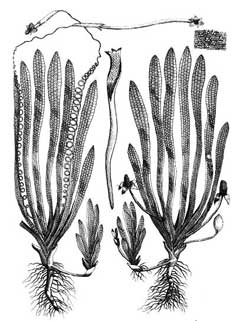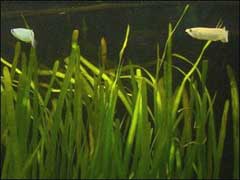 |
|
commons.wikimedia.org/wiki/File:Vallisneria_spiralis_Erasmus_Darwin_1789.jpg |
 |
|
Translate this page:
Summary
Physical Characteristics
![]()
![]() Vallisneria spiralis is an evergreen Perennial.
Vallisneria spiralis is an evergreen Perennial.
See above for USDA hardiness. It is hardy to UK zone 8. It is in leaf all year, in flower from June to October. The species is dioecious (individual flowers are either male or female, but only one sex is to be found on any one plant so both male and female plants must be grown if seed is required). and is pollinated by Water. The plant is not self-fertile.
Suitable for: light (sandy), medium (loamy) and heavy (clay) soils. Suitable pH: mildly acid, neutral and basic (mildly alkaline) soils. It cannot grow in the shade. It can grow in water.
UK Hardiness Map
US Hardiness Map
Synonyms
Plant Habitats
Pond;
Edible Uses
Edible Parts: Leaves
Edible Uses:
Young leaves - raw[46, 61, 105]. The dried leaves contain 14.1% ash, 1154mg calcium, 3205mg phosphorus and 141mg iron per 100g[218].
References More on Edible Uses
| Composition
|
| Figures in grams (g) or miligrams (mg) per 100g of food.
|
|
|
Leaves (Dry weight)
|
|
- 0 Calories per 100g
- Water : 0%
- Protein: 0g; Fat: 0g; Carbohydrate: 0g; Fibre: 0g; Ash: 14.1g;
- Minerals - Calcium: 1154mg; Phosphorus: 3205mg; Iron: 141mg; Magnesium: 0mg; Sodium: 0mg; Potassium: 0mg; Zinc: 0mg;
- Vitamins - A: 0mg; Thiamine (B1): 0mg; Riboflavin (B2): 0mg; Niacin: 0mg; B6: 0mg; C: 0mg;
- Reference: [ 218]
- Notes:
|
|
Medicinal Uses
Plants For A Future can not take any responsibility for any adverse effects from the use of plants. Always seek advice from a professional before using a plant medicinally.
Appetizer Demulcent Refrigerant Stomachic Women's complaints
The plant is aperitif, demulcent, refrigerant, stomachic and is also used in the treatment of women's complaints[178, 218, 240]. The plant is used in the treatment of leucorrhoea[178, 218] and is made into a tea with Sesame (Sesamum indicum) to improve the appetite[218].
References More on Medicinal Uses
The Bookshop: Edible Plant Books
Our Latest books on Perennial Plants For Food Forests and Permaculture Gardens in paperback or digital formats.

Edible Tropical Plants
Food Forest Plants for Hotter Conditions: 250+ Plants For Tropical Food Forests & Permaculture Gardens.
More

Edible Temperate Plants
Plants for Your Food Forest: 500 Plants for Temperate Food Forests & Permaculture Gardens.
More

More Books
PFAF have eight books available in paperback and digital formats. Browse the shop for more information.
Shop Now
Other Uses
References More on Other Uses
Cultivation details
A water plant for a large aquarium or for deep water outdoors[1], it prefers slightly acid conditions in a sunny position[200]. This species is not very hardy in Britain, though it should succeed outdoors in the mildest areas of the country[200]. A valuable water oxygenator[200]. The leaves can be up to 1 metre long[1]. Dioecious, male and female plants must be grown if seed is required. Male flowers are produced below the surface of the water and females are produced on the surface. Fertilization takes place when male flowers break off the plant, float to the surface and fall into a slight depression formed by the female flowers on the surface of the water[274].
References Carbon Farming Information and Carbon Sequestration Information
Temperature Converter
Type a value in the Celsius field to convert the value to Fahrenheit:
Fahrenheit:
The PFAF Bookshop
Plants For A Future have a number of books available in paperback and digital form. Book titles include Edible Plants, Edible Perennials, Edible Trees,Edible Shrubs, Woodland Gardening, and Temperate Food Forest Plants. Our new book is Food Forest Plants For Hotter Conditions (Tropical and Sub-Tropical).
Shop Now
Plant Propagation
Seed - we have no information on this species but suggest sowing the seed in a warm greenhouse as soon as it is ripe. Lay the seed on the surface of a pot of soil and immerse this in water. When they are large enough to handle, prick the seedlings out into individual pots and grow them on in water in the greenhouse for their first winter. Plant them out into their permanent positions in late spring or early summer, after the last expected frosts. Division of rooted runners in the growing season.
Other Names
If available other names are mentioned here
Native Range
TEMPERATE ASIA: Iraq, Turkey, Russian Federation-Ciscaucasia (Ciscaucasia), Uzbekistan EUROPE: Switzerland, Hungary, Russian Federation (European part), Moldova, Russian Federation (Kalmykija, Respublika, Astrakhan, Saratov, Volgogradskaja oblast), Ukraine, Albania, Bulgaria, Greece, Croatia, Italy, Montenegro, Romania, France, Portugal AFRICA: Algeria, Egypt, Sudan, Uganda
Weed Potential
Right plant wrong place. We are currently updating this section.
Please note that a plant may be invasive in one area but may not in your area so it's worth checking.
Conservation Status
IUCN Red List of Threatened Plants Status :

Growth: S = slow M = medium F = fast. Soil: L = light (sandy) M = medium H = heavy (clay). pH: A = acid N = neutral B = basic (alkaline). Shade: F = full shade S = semi-shade N = no shade. Moisture: D = dry M = Moist We = wet Wa = water.
Now available:
Food Forest Plants for Mediterranean Conditions
350+ Perennial Plants For Mediterranean and Drier Food Forests and Permaculture Gardens.
[Paperback and eBook]
This is the third in Plants For A Future's series of plant guides for food forests tailored to
specific climate zones. Following volumes on temperate and tropical ecosystems, this book focuses
on species suited to Mediterranean conditions—regions with hot, dry summers and cool, wet winters,
often facing the added challenge of climate change.
Read More
Expert comment
Author
L.
Botanical References
50200
Links / References
For a list of references used on this page please go here
Readers comment